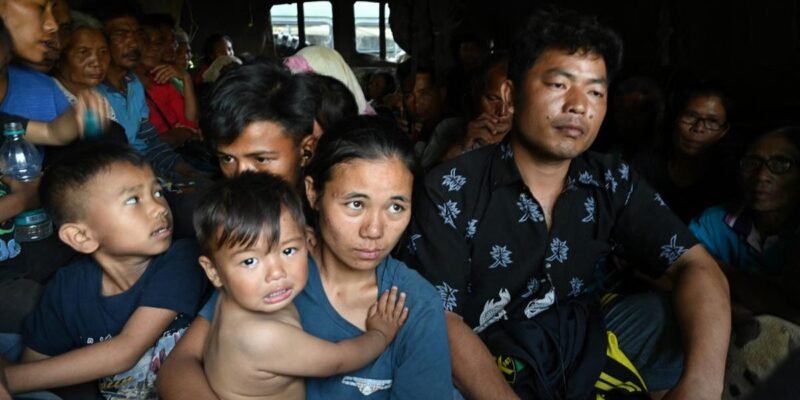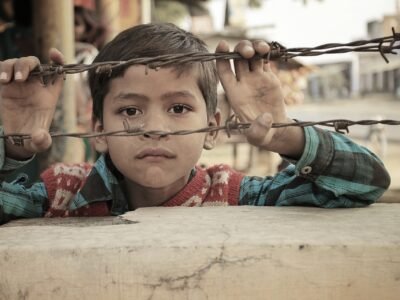
Author: Kamakshi, 1st year student at Vivekananda Institute of Profesional Studies.
Introduction
The recent ongoing scuffle in Manipur which is a northeastern state within the territory of India, whose capital is Imphal and has a geographical area of approximately 22,327 sq km[1] has its roots in the complex historical background and socio-political situation of the state. One of the major drawbacks of the ongoing battle in Manipur along with several others is the critical impact the situation has on the children by directly or indirectly violating their rights that are catalyzed by the prolonged ethnic violence and the current scenario of political instability in the region.
Manipur Conflicts: An Overview
The state of Manipur is an integral part of the seven sisters of India and holds the utmost geographical significance for the nation. The region shares an international border with Myanmar for about 352 km[2] thus providing it with a special strategic position intertwined with its rich historical past.
After India gained independence in the year 1947, it took a short while to fully form the geographical and political borders of the nation as we know it today. Manipur was finally merged into India on 15th Oct 1949 [3]however it was not till 1972[4] that the area achieved the title of statehood. The root cause of the current political turmoil in the region lies beneath its complex demographics comprising people from several ethnicities. For instance, according to the census of 2011, the total population of Manipur is 28.56 lakh out of which 64% of the population belongs to one ethnic group known as Meitei while the rest consists of people from ethnicities like Nagas, Kukis, etc. [5]This compilation further complicates the matter and has its repercussions on innocents, a major proportion of whom are children.
Consequently, the complexity of the area has extended the number of atrocities the children are suffering from which includes offenses like displacement of kids, mishandling of minors by police, and killing of children to count a few.
Current Scenario
The violence stemming from the ethnic conflict in the region has a particularly strong impact on the children. As per the 2011 Census, the child population of Manipur was reported to be 1,098,379 individuals, which accounts for 38 percent of the total population of Manipur. Children in the age group of 0-6 constitute around 13 percent of the total population, while those between 14 and 18 years old make up 8.3 percent of the total state population[6].
The children’s rights amidst the conflict pertaining to articles 6,24, 28, and 29 of UNCRC (Convention on the Rights of Children) [7]are directly affected. As per the articles, Children have a right to life, survival, and development under Article 6, [8]the right to health under Art 24[9], right to an adequate standard of living under Art. 28[10], and 29. However, during the ongoing turmoil, we can observe a direct violation of it.
For instance, children in Manipur have been frequently subjected to violence at the hands of police. In the case of the mishandling of two minors by police in relation to an arson attack which is violative of the Juvenile Justice (Care and Protection of Children) Act, 2015[11], because the state police allegedly mishandled them by treating them brutally and detaining them without priorly informing their parents during the initial hours of detention. Consequently violating the rights given to each and every citizen of India through the power of the constitution. The JJ Act act is the primary legal framework for addressing issues related to children in conflict with the law and those in need of care and protection. It mandates special procedures for the arrest, investigation, and trial of juveniles. In the present case, the detention of minors was not in compliance with the law and provisions of the act. The Act further prohibits the detention of children in police lockups and mandates that they be placed in observation homes instead. It also requires the establishment of Juvenile Justice Boards and Child Welfare Committees to handle cases involving children. All these provisions and necessary protocols of the act were blatantly ignored in Manipur by the state police and thus indicate a bigger issue in the region that is parallel to the ethnic conflict between Meitei and Kuki-Zo groups.
In addition to these violations, in the ‘disturbed area’ of Manipur, children’s right to life and education, which are granted to them by the constitution itself under articles 21[12] and 21 A [13]respectively, and under the Right to Education Act, 2009[14] were also infringed upon due to the direct result of the conflict. The sphere of the situation at hand in Manipur extends to the violation of article 39 (f)[15] which reads “that children are given opportunities and facilities to develop in a healthy manner and in conditions of freedom and dignity and that childhood and youth are protected against exploitation and against moral and material abandonment.” The existing situation vividly demonstrates the complete and unmistakable breach of constitutional provisions intended to protect the rights and well-being of children by the state police, as a result of the turmoil in the region.
Consequently, in the present scenario, a huge number of children are facing the issue of displacement due to the ethnic conflicts and situation of insurgency in the region. This conflict has critically impacted the lives of local people as there is a violent clash between the Meitei, Naga, and Kuki groups over a number of issues. A most prominent area of conflict between the groups is the right to land which has disturbed the delicate balance of peace in the region. Subsequently, more than 200 children have been illegally displaced from Manipur to other states by their parents in order to secure their education and life. This critical step by parents strongly indicates the direction of mistreatment that people there are subjected to go through on a daily basis that is remarkably making their life more difficult as the day goes by. It also acts as a sign for the government to take some strong measures to curb the situation of insurgency and militancy in the area by taking the initiative by either conducting peace dialogues or curbing the violence by appropriate usage of policies and legal frameworks.
Conclusion
The challenges faced in Manipur are multifaceted, first and foremost continuous violence and instability make it difficult to implement and sustain child rights initiatives combined with ethnic divisions and mistrust that hinder the implementation of child rights programs across different communities. These obstacles when coupled with a scenario of limited resources and funding, further constrains the ability of the government and NGOs to provide adequate support and services to affected children.
In order to tackle these challenges, it’s important to strengthen laws and regulations to safeguard children from recruitment and violence by involving local communities in initiatives to protect children, which is crucial to ensure greater acceptance and collaboration. It is also vital to seek assistance from international organizations to provide resources, expertise, and oversight to safeguard children’s rights in conflict zones.
The region’s long-term peace and stability efforts will pave the way for the full realization of children’s rights. A comprehensive approach should be considered involving legal, social, and political endeavors is essential to address child rights in Manipur and safeguard and advance the well-being of children amid the ongoing conflict.
[1] Manipur State Profile, DCMSE.
[2] Ibid.
[3] Manipur Merger Agreement, South Asia Terrorism Portal (1949).
[4] Shikha Goyal, Tripura Manipur and Meghalaya Foundation Day 2024: History, Significance & a lot more to know (Published on: Jan. 21, 2024).
[5] The Census of India, Registrar General and Central Commissioner of India, 2011.
[6] Ibid.
[7] United Nations Convention on the Rights of Children.
[8] Ibid.
[9] Supra note 6.
[10] Supra note 6.
[11] The Juvenile Justice (Care and Protection of Children) Act, 2015.
[12] India Const., art. 21.
[13] India Const., art. 21 A.
[14] The Right to Education Act, 2009.
[15] India Const., art. 39, cl. f.


Wow this is so informative and the level of hardwork and efforts you’ve put into this is so commendable
Loved this blog. tooo accurate
Enthusiastic learning!